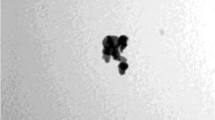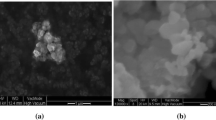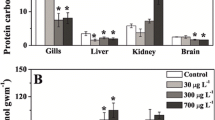Abstract
Accumulation of copper oxide nanoparticles (CuO NPs) in gill, liver and muscle tissues of Oreochromis niloticus and its effects on superoxide dismutase (SOD), catalase (CAT) and glutathione peroxidase (GPx) activities in gill and liver tissues were studied after exposing the fish to 20 µg/L Cu over 15 days. Copper levels and enzyme activities in tissues were determined using spectrophotometric (ICP-AES and UV) techniques respectively. No mortality was observed during the experiments. Copper levels increased in gill and liver tissues of O. niloticus compared to control when exposed to CuO NPs whereas exposure to metal had no effect on muscle level at the end of the exposure period. Highest accumulation of copper was observed in liver while no accumulation was detected in muscle tissue. SOD, CAT activities decreased and GPx activity increased in gill and liver tissues when exposed to CuO NPs.




Similar content being viewed by others
References
Abdel-Khalek AA, Kadry MAM, Badran SR, Marie MS (2015) Comparative toxicity of copper oxide bulk and nano particles in Nile tilapia; Oreochromis niloticus: biochemical and oxidative stress. J Basic Appl Biol 72:43–57
Bebianno MJ, Géret F, Hoarau P, Serafim MA, Coelho MR, Gnassia-Barelli M, Roméo M (2004) Biomarkers in Ruditapes decussatus: a potential bioindicator species. Biomarkers 9(4–5):305–330
Bradford M (1976) A rapid and sensitive method for the quantitation of microgram quantities of protein utilizing the principle of protein-dye binding. Anal Biochem 72:248–254
Bryan GW, Langston WJ (1992) Bioavailability, accumulation and effects of heavy metals in sediments with special reference to United Kingdom estuaries: a review. Environ Pollut 76:89–131
Cicik B (2003) Bakır-çinko etkileşiminin sazan (Cyprinus carpio)’ın karaciğer, solungaç ve kas dokularındaki metal birikimi üzerine etkileri. Ekoloji 12(48):32–36
Gomes T, Pinheiro JP, Cancio I, Pereira CG, Cardoso C, Bebianno MJ (2011) Effects of copper nanoparticles exposure in the mussel Mytilus galloprovincialis. Environ Sci Technol 45(21):9356–9362
Gomes T, Pereira CG, Cardoso C, Pinheiro JP, Cancio I, Bebianno MJ (2012) Accumulation and toxicity of copper oxide nanoparticles in the digestive gland of Mytilus galloprovincialis. Aquat Toxicol 118–119:72–79
Greenwald RA (1985) Handbook of methods for oxygen radical research. CRC Press, Boca Raton
Griffitt RJ, Weil R, Hyndman KA, Denslow ND, Powers K, Taylor D, Barber SD (2007) Exposure to copper nanoparticles causes gill injury and acute lethality in zebrafish (Danio rerio). Environ Sci Technol 41:8178–8186
Heath AG (1995) Water pollution and fish physiology. CRC press, Boca Raton
Khallaf EA, Galal M, Authman M (1998) Assessment of heavy metals pollution and their effects on Oreochromis niloticus in aquatic drainage canals. J Egypt Ger Soc Zool 26(B):39–74
Klaine SJ, Alvarez PJJ, Batley GE, Fernandes TF, Handy RD, Lyon DY, Mahendra S, McLaughlin M, Lead JR (2008) Nanomaterials in the environment: behavior, fate, bioavailability and effects. Environ Toxicol Chem 27(9):1825–1851
Lawrence RA, Burk RF (1976) Glutathione peroxidase activity in selenium-deficient rat liver. Biochem Biophys Res Commun 71:952–958
Lesser MP (2006) Oxidative stress in marine environments: Biochemistry and physiology ecology. Annu Rev Physiol 68:253–278
McCord JM, Fridovich I (1969) Superoxide dismutase: an enzymatic function for erythrocuprein (hemocuprein). J Biol Chem 244(22):6049–6055
Muramoto S (1983) Elimination of copper from Cu contaminated fish by long- term exposure to EDTA and freshwater. J Environ Sci Health 18(3):455–461
Nussey G, Van Vuren JHJ, Du Preez HH, (1995) Effect of copper on the hematology and osmoregulation of the Mozambique tilapia, Oreochromis mossambicus (Cichlidae). Comp Biochem Physiol 111C(3):369–380
Shaw BJ, Al-Bairuty G, Handy RD (2012) Effects of waterborne copper nanoparticles and copper sulphate on rainbow trout, (Oncorhynchus mykiss): Physiology and accumulation. Aquat Toxicol 116–117:90–101
Tunçsoy M, Erdem C (2014) Accumulation of copper, zinc and cadmium in liver, gill and muscle tissues of Oreochromis niloticus exposed to these metals separately and in mixture. Fresen Environ Bull 23(5):1143–1149
Unfried K, Albrecht C, Klotz L, Mikecz AV, Grether-Beck S, Schins RPF (2007) Cellular responses to nanoparticles: target structures and mechanisms. Nanotoxicology 1(1):52–71
Vıjayavel K, Gopalakrishnan S, Thilagram H, Balasubramanıan MP, (2006) Dietary ascorbic acid and a-tocopherol mitigates oxidative stres ınduced by copper in the thornfish Terapon jarbua. Sci Tot Environ 372:157–163
Wang T, Long X, Cheng Y, Liu Z, Yan S (2014) The potential toxicity of copper nanoparticles and copper sulphate on juvenile Epinephelus coioides. Aquat Toxicol 152:96–104
Wang T, Chen X, Long X, Liu Z, Yan S (2016) Copper nanoparticles and copper sulphate induced cytotoxicity in hepatocyte primary cultures of Epinephelus coioides. PLoS ONE 11(2):1–15
Xia J, Zhou HZ, Guang Hua LU (2013) Effects of selected metal oxide nanoparticles on multiple biomarkers in Carassius auratus. Biomed Environ Sci 26(9):742–749
Acknowledgements
This work was supported by Çukurova University, Scientific Research Projects Coordination Unit. We would like to acknowledge Prof.Dr. Maria João Bebianno, Asst.Prof.Dr. Margarida Ribau Teixeira, Dr. Tânia Gomes and Vânia Sousa.
Author information
Authors and Affiliations
Corresponding author
Rights and permissions
About this article
Cite this article
Tunçsoy, M., Duran, S., Ay, Ö. et al. Effects of Copper Oxide Nanoparticles on Antioxidant Enzyme Activities and on Tissue Accumulation of Oreochromis niloticus . Bull Environ Contam Toxicol 99, 360–364 (2017). https://doi.org/10.1007/s00128-017-2129-z
Received:
Accepted:
Published:
Issue Date:
DOI: https://doi.org/10.1007/s00128-017-2129-z




